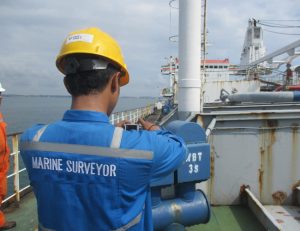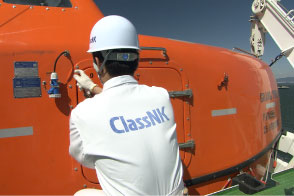Ship surveying is far more than just a perfunctory examination; it’s a meticulous evaluation aimed at gauging a vessel’s structural soundness, operational efficacy, and compliance with safety and environmental standards. This crucial practice is a safeguard that plays an instrumental role in maritime operations. It provides an assurance of safety for the ship, its crew, and the marine environment. Furthermore, ship surveying serves as the gateway to compliance with a host of international and national regulations. The importance of these surveys extends to various spheres, such as insurance, financing, and legal proceedings, as they often necessitate certified survey reports.
The responsibility for conducting these critical surveys often rests with various authoritative bodies. This includes Classification Societies like Lloyd’s Register, DNV GL, and ABS. These entities are accredited by flag state administrations and the International Maritime Organization (IMO) to assess and classify ships. Additionally, flag state administrations—the governmental bodies under which a ship is registered—may execute these surveys themselves or delegate them to other recognized organizations. Alternatively, ship owners and operators might employ third-party, independently accredited surveyors to assess their vessels.

Objectives: Safety and Regulatory Compliance
At the heart of ship surveying is the ambition to guarantee the safety of the ship, its crew, and any cargo onboard. This is executed through thorough inspections to identify structural flaws, mechanical issues, and safety deficiencies that could impede a vessel’s seaworthiness. On the flip side, the process also aims to ensure that ships are in line with international regulations and standards. The IMO, flag state authorities, and classification societies have strict requirements that ships must meet, the adherence to which significantly minimizes the likelihood of maritime accidents and environmental hazards.
The Anatomy of a Ship Survey
Before initiating a ship survey, surveyors engage in a phase of rigorous preparation. This involves the compilation of essential documents, such as the ship’s registration, maintenance logs, and operational manuals. Moreover, an initial inspection of machinery, safety equipment, and navigational systems is undertaken to evaluate their readiness for the formal survey. During this stage, coordination with ship personnel is critical to guarantee that surveyors can access all essential areas aboard the vessel.
Upon commencement of the survey, various elements of the ship are subjected to in-depth scrutiny. This includes a visual examination of the ship’s overall condition, targeted equipment testing like thickness measurements and pressure tests, and a review of all pertinent logs and maintenance records. Occasionally, interviews with crew members may be carried out to extract first-hand accounts of the vessel’s operational history.
Key Focus Areas of a Survey
- Structural Components:
- Hull condition: Scrutinized for corrosion, cracks, or deformities.
- Deck state: Checked for operational equipment like winches and cleats.
- Cargo holds: Evaluated for issues like moisture accumulation.
- Bulkheads and doors: Inspected for watertight integrity.
- Superstructure: Includes assessments of the bridge, galley, and crew accommodations.
- Machinery and Systems:
- Engines: Assessed for wear and tear, and fuel efficiency.
- Electrical infrastructure: Evaluated for operational capability.
- Navigational gear: Checked for accuracy and functionality.
- Pumps and Valves: Examined especially in ballast and bilge systems.
- HVAC systems: Assessed for both operational efficiency and safety standards.
- Safety Equipment:
- Life-saving apparatus: Ensuring lifeboats and life vests are in operational condition.
- Firefighting gear: Tested for operational readiness.
- PPE: Checked for adequacy and condition.
- Safety signage: Evaluated for clarity and visibility.
- Emergency systems: Checked to ensure they work during power failures.

Outcomes: Reporting , Recommendations, and Certification
Upon the conclusion of the survey, the findings are organized into a comprehensive report. This record captures the state of the vessel, highlighting any areas requiring immediate attention. It also serves as a formal document for regulatory compliance. Additionally, the report typically includes recommendations for repairs, upgrades, or replacements—essential actions for maintaining the ship’s safety, seaworthiness, and regulatory compliance.
Ship surveying is an indispensable element in the maritime industry. This intricate procedure aims to reduce risks, protect marine ecosystems, and enforce the highest levels of maritime safety. As maritime technology advances and regulations evolve, the scope and complexity of ship surveys are likely to grow, continually refining the maritime industry’s standards for safety and environmental stewardship.
The Certificate of Class is a pivotal document issued by a classification society, such as Lloyd’s Register, DNV GL, or ABS. This certificate confirms that the ship complies with specific structural and equipment standards established by the society. It signifies the vessel’s seaworthiness and adherence to safety and construction requirements. The Certificate of Class is one of the most critical documents a ship must possess to operate legally and safely.
- Safety Equipment Certificate: This certificate verifies that all safety equipment on board, including life-saving and fire-fighting equipment, has been surveyed and found to be in satisfactory condition. It ensures that the ship is equipped to respond effectively to emergency situations.
- International Oil Pollution Prevention Certificate (IOPP): The IOPP certificate certifies that the ship has undergone examination and that its equipment for controlling oil discharge complies with international regulations, particularly those outlined in Annex I of the International Convention for the Prevention of Pollution from Ships (MARPOL).
- International Load Line Certificate: This certificate confirms that the ship’s loading conditions adhere to the international load line conventions, which set limits on a vessel’s draft based on its size and type. It ensures that the ship is not overloaded, maintaining its stability and safety at sea.
- Cargo Ship Safety Radio Certificate: This certificate attests that the ship’s radio communications equipment is in working condition and conforms to international regulations, including those specified in the International Telecommunication Union (ITU) Radio Regulations.
Verification Procedures: Types of Surveys and Their Frequency:
- Initial Survey: This survey is conducted for a new ship before it enters service. Its purpose is to ensure that the vessel complies with design and equipment standards. It is a one-time survey.
- Annual Survey: Conducted annually, this survey assesses the ship’s overall condition, equipment, and safety systems to ensure they are in satisfactory condition and suitable for the intended service.
- Intermediate Survey: Conducted between the second and third anniversary dates of the certificate, this survey ensures that the ship maintains compliance with the standards established during annual surveys.
- Renewal Survey: Performed every four to five years, depending on the classification society and flag state requirements, this comprehensive survey aims to renew certificates like the Certificate of Class. It involves a thorough examination of the ship, akin to an in-depth annual survey.
- Dry-Docking Survey: Typically conducted every two to three years, this survey involves taking the ship out of the water for a detailed inspection of its underwater components, including the hull, propeller, and rudder.
- Special Survey: Conducted every four to five years, this extensive survey provides comprehensive scrutiny of the ship’s structure, machinery, and equipment, ensuring their continued compliance with standards.
- Tail Shaft Survey: Typically conducted every four to five years, this survey involves inspecting the propeller shafts and tube shafts to ensure their integrity and safety.
- Boiler Survey: Exhaust gas boilers are usually surveyed annually, while other types of boilers are inspected every two years to ensure safe and efficient operation.
- Safety Equipment Survey: Conducted annually, this survey focuses exclusively on the ship’s safety equipment, ensuring it remains in operational condition.
- Additional Surveys: Unscheduled surveys may be required due to repairs, modifications, or after the vessel has been involved in an accident to ensure its continued compliance and safety.
Regulatory Considerations:
- Flag State Requirements: The country where the ship is registered may impose specific regulations regarding the frequency and scope of surveys. Flag states establish the legal framework for surveying and vessel operation.
- Classification Society Guidelines: Different classification societies have their own rules, guidelines, and requirements for surveys that must be adhered to by shipowners and operators. These guidelines ensure the vessel’s compliance with industry standards.
- International Regulations: Various international conventions and codes, such as SOLAS (Safety of Life at Sea), MARPOL (Marine Pollution), and the Load Line Convention, outline specific survey requirements to enhance maritime safety and environmental protection.
Understanding the types and frequencies of surveys is crucial for maintaining a vessel’s operational status and ensuring compliance with international and national regulations. Shipowners and operators should always refer to the latest guidelines and regulations from the flag state and the classification society to remain compliant and operate safely.
Non-Compliance Consequences
Potential Detentions: Non-compliance with survey requirements and safety standards can lead to the detention of a ship at port. Port state control authorities have the authority to detain vessels found to be non-compliant until all identified issues are adequately addressed. Detention not only disrupts the ship’s operations but can also result in financial losses for the shipowner.
Withdrawal of the Class: In severe cases of non-compliance, a ship may face the withdrawal of its class status. This means that the classification society may revoke its Certificate of Class, rendering the vessel ineligible for operation under the jurisdiction of most flag states. Losing class status is a significant setback for a shipowner, as it signifies a failure to meet essential safety and structural standards, potentially affecting the ship’s marketability and insurability.
Maintaining compliance with survey requirements is essential not only for operational continuity but also for preserving a ship’s reputation and ensuring the safety of its crew and the marine environment.
